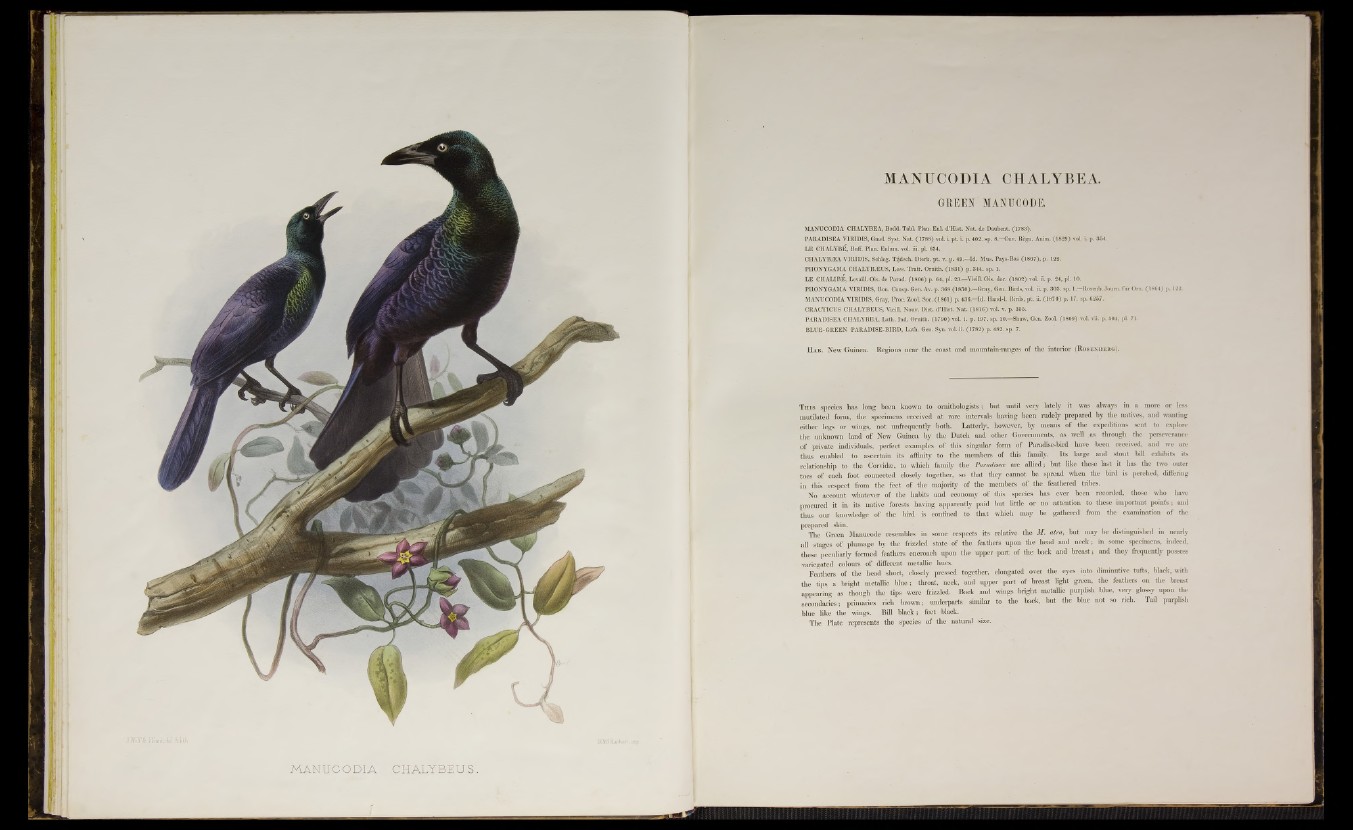
M w p Ä i O H A L S n p E U S .
MANUCODIA CHALYBEA.
GREEN MANECODE.
MANUCODIA CHALYBEA, Bodd.Tabl. Plan. Eni. d’Hist. Nat. de Daubent (1783).
PARADISEA VIRIDIS, Gmel. Syst. Nat. (1788) vol. i. pt. i. p. 402. sp. 8.—Cuv. Regn. Anim. (1829) vol. i. p. 354.
LE CHALYBE, Buff. Plan; Enlum. wfll iii. pl. 634.
CHALYBA3A VIRIDIS, Scbleg. Tijdscli. Dierk. pt. v. p. 49.—Id. Mus. Pays-Bas (1867), p. 122.
PHONYGAMA CHALYBA5US, Less. Trait. Ornith. (1831) p. 344. sp. 1.
LE CHALIBE, Levaill. Ois. de Parad. (1806) p. 64, pl. 23.—Vieill. Ois. dor. (1802) vol. ii. p. 24, pl. 10.
PHONYGAMÄ VIRIDIS, Bon. Consp. Gen. Av. p. 368 (1850).—Gray, Gen. Birds, vol. ii. p. 303. sp. 1.—Rosenb. Journ. für Om. (1864) p. 122.
MANUCODIA VIRIDIS, Gray, Proc. Zool. Soc. (1861) p. 436—Id. Hand-1. Birds, pt. ii. (1870) p. 17. sp. 6257.
CRACTICUS CHALYBEUS, Vieill. Nouv. Die t d’Hist. Nat. (1816) vol. v .p . 355.
PARADISEA CHALYBEA, Lath. Ind. Ornith. (1790) vol. i. p. 197. sp. 10.—Shaw, Gen. Zool. (1809) vol. vH. p. 504, pl. 71.
BLUE-GREEN PARADISE-BIRD, Lath. Gen. Syn.ypL ii. (1782) p. 482. sp. 7.
H a b . New Guinea. Regions near the coast and mountain-ranges of the interior (Ro se n b e r g ).
T h i s species has long been known to ornithologists; but until very lately it was always in a more or less
mutilated form, the specimens received at rare intervals having been rudely prepared by the natives, and wanting
either legs or wings, not unfrequently both. Latterly, however, by means of the expeditions sent to explore
the unknown land of New Guinea by the Dutch and other Governments, as well as through the perseverance
of private individuals, perfect examples of this singular form of Paradise-bird have been received, and we are
thus enabled to ascertain its affinity to the members of this family. Its large and stout bill exhibits its
relationship to the Corvidae, to which family the Paradisea are allied; but like these last it has the two outer
toes of each foot connected closely together, so that they cannot be spread when the bird is perched, differing
in this respect from the feet of the majority of the members of the feathered tribes.
No account whatever of the habits and economy of this species has ever been recorded, those who have
procured it in its native forests having apparently paid but little or no attention to these important points; and
thus our knowledge of the bird is confined to that which may be gathered from the examination of the
prepared skin.
The Green Manucode resembles in some respects its relative the M. atra, but may be distinguished in nearly
all stages of plumage by the frizzled state of the feathers upon the head and neck; in some specimens, indeed,
these peculiarly formed feathers encroach upon the upper part of the back and breast; and they frequently possess
variegated colours of different metallic hues.
Feathers of the head short, closely pressed together, elongated over the eyes into diminutive tufts, black, with
the tips a bright metallic blue; throat, neck, and upper part of breast light green, the feathers on the breast
appearing as though the tips were frizzled. Back and wings bright metallic purplish blue, very glossy upon the
secondaries; primaries rich brown; underparts similar to the back, but the blue not so rich. Tail purplish
blue like the wings. Bill black; feet black.
The Plate represents the species of the natural size/